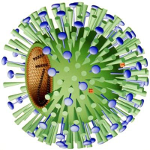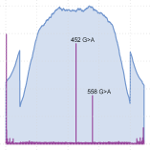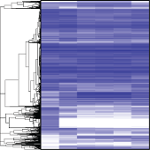 Influenza A virus is a major human pathogen and a global
health threat, thus the development of novel intervention strategies and therapeutics remains paramount. The single-stranded
negative-sense influenza virus genome consists of 8 segments, each flanked by short conserved elements at their termini, which
form the viral promoter that is recognized by the viral RNA-dependent RNA polymerase (vPOL). vPOL is essential for influenza
biogenesis because of its central role in transcription and replication of the viral genome. Mutations in vPOL and factors that
affect vPOL activity can cause adaptation of animal viruses to the human host. Using novel reporter viruses, proteomics, and
next-generation sequencing techniques we are characterizing, in a physiological setting of infection, virus:host interactions,
the basis of viral transcription, and the interplay between cellular and viral transcription at genomic scale. For each of these
processes we are assessing their role in influenza virulence and pathogenesis.
Influenza A virus is a major human pathogen and a global
health threat, thus the development of novel intervention strategies and therapeutics remains paramount. The single-stranded
negative-sense influenza virus genome consists of 8 segments, each flanked by short conserved elements at their termini, which
form the viral promoter that is recognized by the viral RNA-dependent RNA polymerase (vPOL). vPOL is essential for influenza
biogenesis because of its central role in transcription and replication of the viral genome. Mutations in vPOL and factors that
affect vPOL activity can cause adaptation of animal viruses to the human host. Using novel reporter viruses, proteomics, and
next-generation sequencing techniques we are characterizing, in a physiological setting of infection, virus:host interactions,
the basis of viral transcription, and the interplay between cellular and viral transcription at genomic scale. For each of these
processes we are assessing their role in influenza virulence and pathogenesis.
 Despite the availability of vaccines, the influenza
A virus continues to pose a significant burden on human health and causes approximately half a million deaths worldwide every year.
Influenza pandemics in particular can cause high levels of mortality, as exemplified by the 1918 Spanish Flu and more recent
outbreaks of H5N1. Human pandemic viruses typically originate from animal populations such as wild birds and pigs and are able
to spread rapidly, as any existing immunity to human influenza strains is ineffective against the new strain. Very little is
known about the distribution and dynamics of influenza viruses in animal populations, and yet this information is crucial to
understand the origin of pandemics. As a member of the
Center for Research on Influenza Pathogenesis (CRIP) and part of the
CEIRS network, we are performing surveillance of
influenza viruses circulating in animals to help identify strains that are at risk for causing human pandemics.
Despite the availability of vaccines, the influenza
A virus continues to pose a significant burden on human health and causes approximately half a million deaths worldwide every year.
Influenza pandemics in particular can cause high levels of mortality, as exemplified by the 1918 Spanish Flu and more recent
outbreaks of H5N1. Human pandemic viruses typically originate from animal populations such as wild birds and pigs and are able
to spread rapidly, as any existing immunity to human influenza strains is ineffective against the new strain. Very little is
known about the distribution and dynamics of influenza viruses in animal populations, and yet this information is crucial to
understand the origin of pandemics. As a member of the
Center for Research on Influenza Pathogenesis (CRIP) and part of the
CEIRS network, we are performing surveillance of
influenza viruses circulating in animals to help identify strains that are at risk for causing human pandemics.
 Hospital-acquired infections (HAIs) such
as MRSA and C. difficile pose a ubiquitous, insidious, and potentially fatal threat to patients across the country. The Centers
for Disease Control estimate HAIs account for roughly 1.7 million serious infections every year in the United States and cause
or contribute to 99,000 deaths annually with a greater burden in immunocompromised hosts. As part of a multidiciplinary team
at Mount Sinai we are using whole-genome sequencing a means to understand the molecular basis of evolution and transmission of
infectious diseases, host-pathogen interactions, and to identify novel pathogens. We anticipate that a better understanding of
the role of genetic diversity in bacterial infections will result in improved patient care and outcomes.
Hospital-acquired infections (HAIs) such
as MRSA and C. difficile pose a ubiquitous, insidious, and potentially fatal threat to patients across the country. The Centers
for Disease Control estimate HAIs account for roughly 1.7 million serious infections every year in the United States and cause
or contribute to 99,000 deaths annually with a greater burden in immunocompromised hosts. As part of a multidiciplinary team
at Mount Sinai we are using whole-genome sequencing a means to understand the molecular basis of evolution and transmission of
infectious diseases, host-pathogen interactions, and to identify novel pathogens. We anticipate that a better understanding of
the role of genetic diversity in bacterial infections will result in improved patient care and outcomes.
 Craniofacial sutures are the fibrous joints
between bones, allowing growth of the skull from prenatal to postnatal development until adult size is achieved. Proper suture
development is crucial because abnormal suture fusion can require major surgical intervention to restore head and facial appearance
and to prevent secondary damage to the brain, eyes, hearing, breathing, and mastication. Craniosynostosis, the premature fusion of
skull sutures, is a common birth defect, occurring in 1/2500 live births. A more comprehensive understanding of suture biology and
pathology can be aided by knowledge of gene expression profiles of sutures. Therefore, as part of the
FaceBase project we are preparing gene expression atlases of specific populations of cells
from the different subregions of each suture. These atlases will enable rapid discovery of genes not yet known to be expressed in
sutures, reveal the commonalities and differences between sutures that may suggest new hypotheses of suture formation and
differentiation, with wider significance for evolutionary studies of the vertebrate skull, and provide insight into the pathology
of suture fusion.
Craniofacial sutures are the fibrous joints
between bones, allowing growth of the skull from prenatal to postnatal development until adult size is achieved. Proper suture
development is crucial because abnormal suture fusion can require major surgical intervention to restore head and facial appearance
and to prevent secondary damage to the brain, eyes, hearing, breathing, and mastication. Craniosynostosis, the premature fusion of
skull sutures, is a common birth defect, occurring in 1/2500 live births. A more comprehensive understanding of suture biology and
pathology can be aided by knowledge of gene expression profiles of sutures. Therefore, as part of the
FaceBase project we are preparing gene expression atlases of specific populations of cells
from the different subregions of each suture. These atlases will enable rapid discovery of genes not yet known to be expressed in
sutures, reveal the commonalities and differences between sutures that may suggest new hypotheses of suture formation and
differentiation, with wider significance for evolutionary studies of the vertebrate skull, and provide insight into the pathology
of suture fusion.